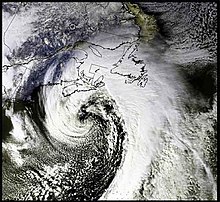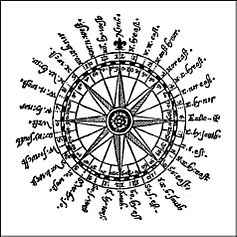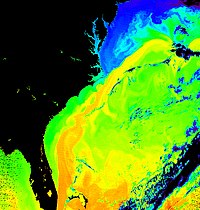Satellite image of the intense nor'easter responsible for the January 2018 North American blizzard. Note the hurricane-like eye at the center.
NASA satellite image of White Juan, an intense nor'easter which struck Atlantic Canada in February 2004.
Typically, such storms originate as a low-pressure area that forms within 100 miles (160 km) of the shore between North Carolina and Massachusetts. The precipitation pattern is similar to that of other extratropical storms. Nor'easters are usually accompanied by very heavy rain or snow, and can cause severe coastal flooding, coastal erosion, hurricane-force winds, or blizzard conditions. Nor'easters are usually most intense during winter in New England and Atlantic Canada. They thrive on converging air masses—the cold polar air mass and the warmer air over the water—and are more severe in winter when the difference in temperature between these air masses is greater.
Nor'easters tend to develop most often and most powerfully between the months of November and March, although they can (much less commonly) develop during other parts of the year as well. The susceptible regions are generally impacted by nor'easters a few times each winter.
Etymology and usage
Compass card (1607), featuring the spelling "Noreast"
The term nor'easter came to American English by way of British English. The earliest recorded uses of the contraction nor (for north) in combinations such as nor'-east and nor-nor-west, as reported by the Oxford English Dictionary, date to the late 16th century, as in John Davis's 1594 The Seaman's Secrets: "Noreast by North raiseth a degree in sayling 24 leagues." The spelling appears, for instance, on a compass card published in 1607. Thus, the manner of pronouncing from memory the 32 points of the compass, known in maritime training as "boxing the compass", is described by Ansted
with pronunciations "Nor'east (or west)," "Nor' Nor'-east (or west),"
"Nor'east b' east (or west)," and so forth. According to the OED, the
first recorded use of the term "nor'easter" occurs in 1836 in a
translation of Aristophanes.
The term "nor'easter" naturally developed from the historical spellings
and pronunciations of the compass points and the direction of wind or
sailing.
As noted in a January 2006 editorial by William Sisson, editor of Soundings magazine,
use of "nor'easter" to describe the storm system is common along the
U.S. East Coast. Yet it has been asserted by linguist Mark Liberman (see
below) that "nor'easter" as a contraction for "northeaster" has no
basis in regional New England dialect; the Boston accent would elide the "R": no'theastuh'.
He describes nor'easter as a "fake" word. However, this view neglects
the little-known etymology and the historical maritime usage described
above.
19th-century Downeast mariners pronounced the compass point "north northeast" as "no'nuth-east", and so on. For decades, Edgar Comee, of Brunswick, Maine,
waged a determined battle against use of the term "nor'easter" by the
press, which usage he considered "a pretentious and altogether
lamentable affectation" and "the odious, even loathsome, practice of
landlubbers who would be seen as salty as the sea itself". His efforts,
which included mailing hundreds of postcards, were profiled, just before
his death at the age of 88, in The New Yorker.
Despite the efforts of Comee and others, use of the term continues by the press. According to Boston Globe writer Jan Freeman,
"from 1975 to 1980, journalists used the nor’easter spelling only once
in five mentions of such storms; in the past year (2003), more than 80
percent of northeasters were spelled nor'easter".
University of Pennsylvania linguistics professor Mark Liberman
has pointed out that while the Oxford English Dictionary cites examples
dating back to 1837, these examples represent the contributions of a
handful of non-New England poets and writers. Liberman posits that
"nor'easter" may have originally been a literary affectation,
akin to "e'en" for "even" and "th'only" for "the only", which is an
indication in spelling that two syllables count for only one position in
metered verse, with no implications for actual pronunciation.
However, despite these assertions, the term can be found in the
writings of New Englanders, and was frequently used by the press in the
19th century.
- The Hartford Times reported on a storm striking New York in December 1839, and observed, "We Yankees had a share of this same "noreaster," but it was quite moderate in comparison to the one of the 15h inst."
- Thomas Bailey Aldrich, in his semi-autobiographical work The Story of a Bad Boy (1870), wrote "We had had several slight flurries of hail and snow before, but this was a regular nor'easter".
- In her story "In the Gray Goth" (1869) Elizabeth Stuart Phelps Ward wrote "...and there was snow in the sky now, setting in for a regular nor'easter".
- John H. Tice, in A new system of meteorology, designed for schools and private students (1878), wrote "During this battle, the dreaded, disagreeable and destructive Northeaster rages over the New England, the Middle States, and southward. No nor'easter ever occurs except when there is a high barometer headed off and driven down upon Nova Scotia and Lower Canada."
Usage existed into the 20th century in the form of:
- Current event description, as the Publication Committee of the New York Charity Organization Society wrote in Charities and the commons: a weekly journal of philanthropy and social advance, Volume 19 (1908): "In spite of a heavy "nor'easter," the worst that has visited the New England coast in years, the hall was crowded."
- Historical reference, as used by Mary Rogers Bangs in Old Cape Cod (1917): "In December of 1778, the Federal brig General Arnold, Magee master and twelve Barnstable men among the crew, drove ashore on the Plymouth flats during a furious nor'easter, the "Magee storm" that mariners, for years after, used as a date to reckon from."
- A "common contraction for "northeaster"", as listed in Ralph E. Huschke's Glossary of Meteorology (1959).
Geography and formation characteristics
Surface temperature of the sea off the east coast of North America. The corridor in yellow gives the position of the Gulf Stream
Formation
Nor'easters develop in response to the sharp contrast in the warm Gulf Stream
ocean current coming up from the tropical Atlantic and the cold air
masses coming down from Canada. When the very cold and dry air rushes
southward and meets up with the warm Gulf stream current, which is often
near 70 °F (21 °C) even in mid-winter, intense low pressure develops.
In the upper atmosphere, the strong winds of the jet stream remove and replace rising air from the Atlantic more rapidly than the Atlantic air is replaced at lower levels; this and the Coriolis force
help develop a strong storm. The storm tracks northeast along the East
Coast, normally from North Carolina to Long Island, then moves toward
the area east of Cape Cod. Counterclockwise winds around the low-pressure system
blow the moist air over land. The relatively warm, moist air meets cold
air coming southward from Canada. The low increases the surrounding
pressure difference, which causes the very different air masses to
collide at a faster speed. When the difference in temperature of the air
masses is larger, so is the storm's instability, turbulence, and thus
severity.
The nor'easters taking the East Coast track usually indicates the presence of a high-pressure area in the vicinity of Nova Scotia.
Sometimes a nor'easter will move slightly inland and bring rain to the
cities on the coastal plain (New York City, Philadelphia, Baltimore,
etc.) and snow in New England (Boston northward). It can move slightly
offshore, bringing a wet snow south of Boston to Richmond, Virginia, or
even parts of the Carolinas.
Such a storm will rapidly intensify, tracking northward and following
the topography of the East Coast, sometimes continuing to grow stronger
during its entire existence. A nor'easter usually reaches its peak
intensity while off the Canadian coast. The storm then reaches Arctic areas, and can reach intensities equal to that of a weak hurricane. It then meanders throughout the North Atlantic and can last for several weeks.
Characteristics
Nor'easters are usually formed by an area of vorticity
associated with an upper-level disturbance or from a kink in a frontal
surface that causes a surface low-pressure area to develop. Such storms
are very often formed from the merging of several weaker storms, a
"parent storm", and a polar jet stream mixing with the tropical jet
stream.
Until the nor'easter passes, thick, dark, low-level clouds often
block out the sun. Temperatures usually fall significantly due to the
presence of the cooler air from winds that typically come from a
northeasterly direction. During a single storm, the precipitation can
range from a torrential downpour to a fine mist. All precipitation types
can occur in a nor'easter. High wind gusts, which can reach hurricane
strength, are also associated with a nor'easter. On very rare occasions,
such as in the nor'easter in 1978, North American blizzard of 2006, and January 2018 North American blizzard, the center of the storm can take on the circular shape more typical of a hurricane and have a small "dry slot" near the center, which can be mistaken for an eye, although it is not an eye.
Difference from tropical cyclones
Often, people mistake nor'easters for tropical cyclones
and do not differentiate between the two weather systems. Nor'easters
differ from tropical cyclones in that nor'easters are cold-core
low-pressure systems, meaning that they thrive on drastic changes in
temperature of Canadian air and warm Atlantic waters. Tropical cyclones
are warm-core low-pressure systems, which means they thrive on purely
warm temperatures.
Difference from other extratropical storms
A nor'easter is formed in a strong extratropical cyclone, usually experiencing bombogenesis.
While this formation occurs in many places around the world,
nor'easters are unique for their combination of northeast winds and
moisture content of the swirling clouds. Nearly similar conditions
sometimes occur during winter in the Pacific Northeast (northern Japan
and northwards) with winds from NW-N. In Europe, similar weather systems
with such severity are hardly possible; the moisture content of the
clouds is usually not high enough to cause flooding or heavy snow,
though NE winds can be strong.
Geography
The eastern United States, from North Carolina to Maine, and Eastern Canada
can experience nor'easters, though most often they affect the areas
from New England northward. The effects of a nor'easter sometimes bring
high surf and strong winds as far south as coastal South Carolina. Nor'easters cause a significant amount of beach erosion in these areas, as well as flooding in the associated low-lying areas.
Biologists at the Woods Hole Oceanographic Institution on Cape Cod have determined nor'easters are an environmental factor for red tides on the Atlantic coast.




